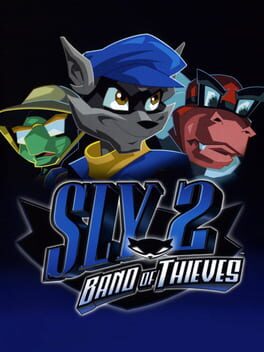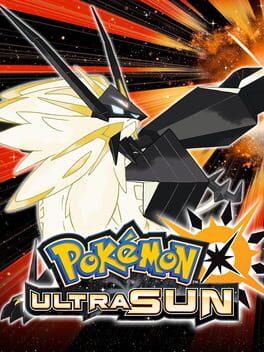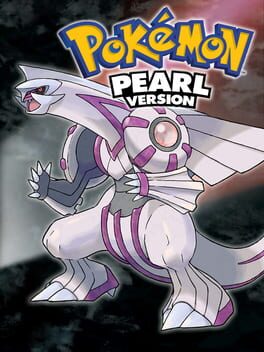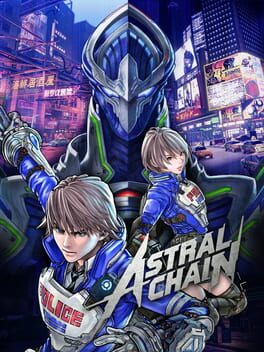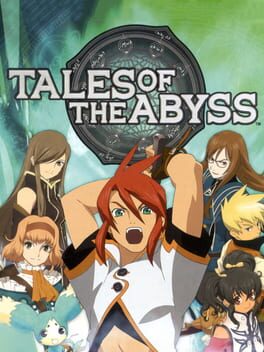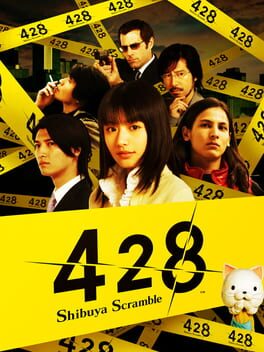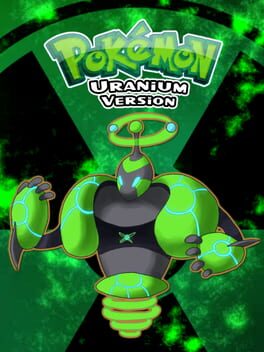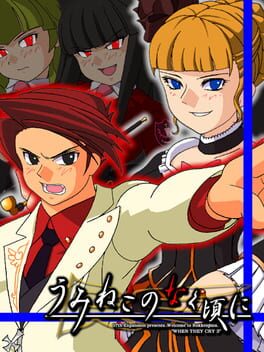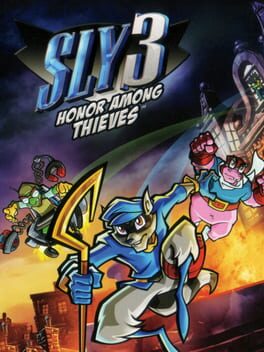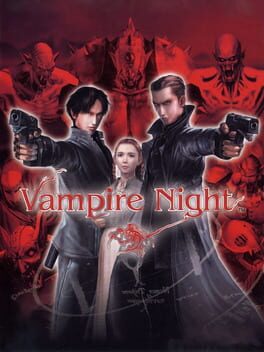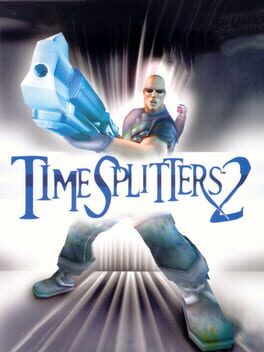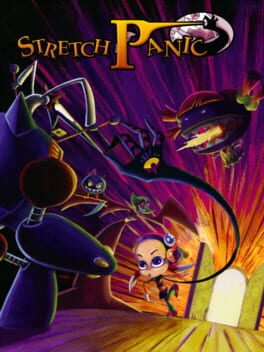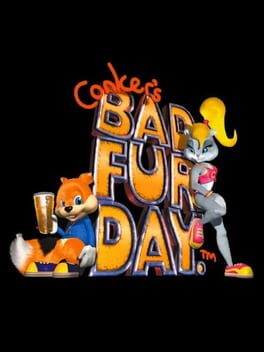SunlitSonata
2017
The Ultra Necromza fight genuinely owns, but there's not enough differences to make it feel like you're playing a new game; it's basically the same but with slightly more endgame and massively undermining the plot of the original Sun/Moon game. Unfortunately set the tone for Sword and Shield to follow.
2019
When you get into combat with the well-thought out Legion system and experience the gorgeously animated sci-fi setting with the well integrated UI, it's great.
When you're doing ANYTHING ELSE, it really isn't. There's nuggets of fun gameplay in here but they're buried under overly long investigation segments, shitty stealth, unfun required side missions and a shockingly bland story. Not awful but could've been much more, and I hope if this game gets a sequel we get a tighter iteration on the formula.
When you're doing ANYTHING ELSE, it really isn't. There's nuggets of fun gameplay in here but they're buried under overly long investigation segments, shitty stealth, unfun required side missions and a shockingly bland story. Not awful but could've been much more, and I hope if this game gets a sequel we get a tighter iteration on the formula.
2005
Excellently developed protagonist, strong story with a great thematic thrust, a compelling cast of villains that serve as complimentary rivals..............................................................................
All that compounded by a tedious, boring, backtrack loaded emptily designed game. There's so little to sink into with the combat systems on offer and most of the dungeons are just walking from entrance to exit or putting colored balls in the right holes. Maybe there was one good puzzle but I don't know if it was required or not. There's an overly long segment which just consists of your party split in half walking across the map from location to location and having to forcibly stop for a cutscene if you're doing it too long. It's atrocious. The game also feels optimized poorly for PS2. Merely saving the game takes a solid 7-10 seconds, and trying to move the camera in the overworld results in a ton of lag. But the story kept me interested enough to see it to the end, and for what it's worth, the final dungeon delivers as it should.
Great story but it feels especially rough to experience all of it.
All that compounded by a tedious, boring, backtrack loaded emptily designed game. There's so little to sink into with the combat systems on offer and most of the dungeons are just walking from entrance to exit or putting colored balls in the right holes. Maybe there was one good puzzle but I don't know if it was required or not. There's an overly long segment which just consists of your party split in half walking across the map from location to location and having to forcibly stop for a cutscene if you're doing it too long. It's atrocious. The game also feels optimized poorly for PS2. Merely saving the game takes a solid 7-10 seconds, and trying to move the camera in the overworld results in a ton of lag. But the story kept me interested enough to see it to the end, and for what it's worth, the final dungeon delivers as it should.
Great story but it feels especially rough to experience all of it.
2016
Having been disillusioned by Game Freak shipping out Pokemon Scarlet and Violet with both lackluster graphics AND abysmal performance, I became more curious to check out fangames than the next title, beginning with the fangame that seemed so close to the genuine article Nintendo chucked a DMCA its way several years ago: Pokemon Uranium.
I think the existence of fan games, particularly ones on this level of scale, can be fascinating. When created out of love, they can feel like a fan’s attempt to get more of the specific product they really adore, but they also tend to represent what said fans believe the genuine article had been lacking so they can fill what they perceive as a hole the series left in their hearts themselves.
Anyone can write a fanfiction, but creating a full on GAME to contain that writing actually takes another level of skill, and yet another level beyond that to have said game design feel even slightly like an officially released product. There’s been plenty of horrendously misguided fan games over the years (such dreck as Hunt Down the Freeman and Sonic Omens spring to mind) but I think Pokemon Uranium, despite its amateurish execution in places, is an interesting case that shows how far passion can go when trying to fill a void.
It probably further helps that mainline Pokemon, for years, has been a series of very low-tech games holding the kind of longstanding legacy where game mechanic concepts are constantly being changed on a micro level despite the macro concept being a constant. Thus, Pokemon Uranium brings a Generation 4 overworld with Generation 5 battle UI and Generation 6 battle mechanics.
You know you’re getting into a fan game story very fast when just starting the game shows you the heartbreaking story of your character’s mother dying in a power plant explosion and their father, a Pokemon Ranger, became cold and distant from you. After this introduction though, things mellow out and a lot of what you would expect to be in working order falls right into place.
Most of Uranium plays as you would expect from a sprite based Pokemon game. Explore a region, battle trainers along the way by making eye contact, defeat 8 gym leaders to collect badges to challenge the League to become champion, use HMs to gradually explore the world they couldn’t before, basic stuff. But there’s an admirable level of commitment in many spots. The game has a full day/night cycle it tracks with your computer. There’s over 100 original “fakemons” in this, and while it does make the arbitrary amount of true Pokemon stick out like a sore thumb, a fair amount of the designs do veer close to the mix of cutesy charm and anime cool Ken Sugimori has really refined over the years, in particular with Pokemon like the starter trio, the many Bug type variants, Urayne as a box Legendary and especially Nucleon, which fits right in with the other Eeveelutions present. I like that Uranium decides to make Double Battles take occasional prominence after the main series has shunted them out for years; they offer a level of additional planning without the gimmickier styles tested in Generation 5. The Elite Four is structured more like the anime, where it’s arena battles between randomly pooled opponents in a tournament bracket where neither side can heal, and that was a very distinct addition. There’s a Game Corner, you can rematch numerous trainers if they call you, there’s a sidequest where if you complete it, you get free grinding spots which is extremely helpful, one of the towns has a berry trading economy in lieu of a shop which is another standout moment feature that fits, and Legen Town’s aesthetic of feeling like it takes place inside a medieval castle made it a pretty memorable town. There’s a minigame to raise IVs if you’re into that stuff, and as a game it will offer more of a challenge even in a standard run than any of the mainlines. The original music is quite impressive for a fangame. It can be very rocking at times, but it can also be quite cozy in other places, with the use of synthesizers working well to punctuate the game’s original creation in Nuclear Pokemon.
That being said, despite all these nice touches, there are other aspects that feel noticeably undercooked, or straight up unpolished to the level you’d expect if this was an actually released title. Sometimes, it’s an imperceptible feeling, like when it feels as though wild encounters happen just slightly more often than they should, or that moves with status effects activate slightly more often than they should. Other times, it’s the many lines of comically corny dialogue (which I’ll share at the end) or major inconsistencies in its presentation. Screen tearing is a constant, and it can feel like motion blur in a sprite-based game whenever your character is running or biking around the map. Even in Performance Mode I couldn’t find a way to stop it so look out for that or see if you can find a way around it. Battles also, while they try to emulate the style of Generation 5, aren’t quite there. It can feel very inconsistent on whether a Pokemon’s sprite moves when it’s in battle, as some of the sprites move while others are stuck still. Any attempts at backgrounds are shockingly poor; they try harder to be actual backgrounds than Generation 5, but they have the feeling of taking photographs of sprite art and blurring them before placing them on. As if they were halfway committing to something new but also not fully wanting to abandon the more abstract backgrounds from Gen 5.
I mentioned before that some of the Fakemon were well-designed for what they were but there’s plenty that doesn’t apply toward. Pajay just looks like budget Ho-Oh. Terlard’s battle sprite when using it just looks like two Charizard heads attached together. And the new evolutions feel jarringly at odds with the original visions. The Uranium developers couldn’t have known this at the time, but when Primeape and Dunsparce got new evolutions in Generation 9, they felt perfectly right with the vision and inspiration of the original designs. Dunseraph in Uranium feels completely disconnected from Dunsparce itself on a pure concept design level, which is something I can’t say for the new evolutions for old mons added in Generation 4.
HM moves were always just situational progression blockers, but Uranium doesn’t do as much as it could to take advantage of them. Strength and Surf work as you’d expect; there’s even a few Strength puzzles near the end of the game to have you think a bit, but Rock Smash loses any sort of relevance very quickly after breaking a progression blocker, Dive is used to pass through a single blocker in the main game and nothing else, while Fly, even beyond how late you get it, can only take you to one side of the region or another. Meaning you’ll either have to Surf a bit of distance to get to the other side or pay a bit of currency every time you want to come over. It feels like a clunky tech oversight, compared to mainline Pokemon organizing the entirety of a single region on one map.
For something with both pros and cons: Nuclear Pokemon! They essentially looked at the Shadow Pokemon from Pokemon XD and decided to turn them from tanks into glass cannons. Every Nuclear attack is super effective on every type except Nuclear and Steel, but they’re also weak to every type. It’s an interesting way of punishing you for using Dual Type mons in your team for more type coverage, as it’s likely a single Nuclear attack would do 4X the amount of damage. It’s interesting, and it does help with the game’s honestly rather questionable level curving in the second half, but it also entirely comes down to a speed advantage. If a Nuclear Pokemon goes first and has a high enough attack, it likely kills, but if it's too weak to one shot for any reason, it’ll likely die in a single turn. On your end, this limits their utility without enough grinding, but the game’s main villain, Apocalypse CURIE, has an entire team of these, and will likely hold major level advantages, and therefore speed, if you don’t extensively grind. Which brings up the story itself.
If there’s one constant among many Pokemon stories, it’s the sense of escalation; often you’re going from catching small rats and racoons to defeating entire organizations of domestic terrorists trying to tame the power of God and anime on their side. But in Pokemon Uranium it sort of feels like the heavier plot is tossed off to the side while you go about the standard Gym badge journey. It’s not like in say, Generation 4, where Team Galactic happened to be occupying buildings within and around the major towns. A lot of the key story moments boat you away from the world to power plant islands, two of which hold dungeons with some atmosphere to them, even as the second one puts you in a suit where you have to slowly walk and repels don’t work to stave away random encounters. Some of the only times the plot takes place within the core world itself involves a two-time subplot involving scheming scientists and Garlikid, a Pokemon that really shouldn’t be. The single corniest thing this game’s story does is in this subplot. They introduce a translator device that lets you hear what Pokemon are saying, since until the ending it mostly comes down to “annihilate, kill, kill, human injustice, why am I trapped in a tiny ball.” It’s not endearingly goofy like some of the NPC dialogue ends up being, it’s just cringe, flat out and reminds me why Game Freak wisely stayed away from having the pets communicate their own abuse.
Disconnection from the world aside though, the Apocalypse CURIE encounters are some of the game’s more memorable moments. The twist regarding them is perhaps the most obvious of all time in the history of anything, but their existence in the story with their 12-year-old edgelord dialogue leads into some climatic battles.
But I should asterisk this as another instance where decisions made regarding said encounters would in absolutely no way fly in an officially released product. The first battle with CURIE is behind a door with a timer where you have to reach them in time, or else. The game does warn you about something big being behind this door, but if you save past the door and your team isn’t prepared, the time limit actively prevents grinding, and your file is screwed. Then there’s another encounter at the very end of the game with a Level 85 Legendary to contend with, 15 levels higher than the Elite Four. Its Nuclear type would make it extra vulnerable if not for its insane level jump compared to what’s likely your party at the time giving it speed priority. Losing this battle gives you a non-standard ending without an instant Pokemon Center warp. Meaning, if you decided to save at any point passed the Elite Four entrance, and it’s impossible to win with your current team and item setup, your file is screwed, FOREVER. It’s possible in one way to do even with a lower-level team (Focus Sash + Thunder Wave= likely win) but still, I have no idea how that got through. If you can make it through, the ending itself is overall a pleasant enough way to close out, accompanied by a strong somber music track.
Pokemon Uranium is a mixed bag, some genuinely thoughtful game design inclusions and a decently amount of creativity hurt by technical inconsistencies and overly strenuous market unfriendly design at points, but it reflects the kind of passion fangame creators provide out of love and appreciation for the accomplishments of a series, even if it can be misguided. I’m curious to check out other full on fangames in the future to see if they’ve better balanced those sensibilities, but for now, I’ll leave off by sharing some of the absolutely incredible dialogue contained within this game:
“Okay, listen: How do you get 50 Pikachu on a bus? You poke’em on! Haha, geddit?”
“Mom just doesn’t understand why I hate sand. It’s coarse, and rough…and it gets everywhere!”
(yes they did just reference a prequel meme)
“I love playing video games. Pokemon’s a really fun one. Wanna play?”
“Hey n00b! Wanna see my 1337 skills? Let’s fight!”
“Lololol im a grrrrl gamer! Y aim a girl and I play video gamezzz! o3o.”
“KILL THE INTRUDER CRUSH DESTROY KILL” (from a Pokemon)
“You may know me as Cameron Caine, engineer, private contractor, and father. However, this is not the truth about who I am. My real name is Cameron Stormbringer.”
Thank Arceus! (used as a sub for Thank God because Pokemon god)
HOLY SHINX! (obvious expletive)
A sign saying “Wow, you found this place, good job.”
“I can’t believe it… you SAVED the day. I knew you could SAVE us. …Why am I shouting SAVE you ask? Well… I just think it’s a good idea to SAVE things!” (helpful but still goofy as heck)
“I’M JUST SO HAPPY TO SEE MY FAMILY AGAIN!! sniffle”
I think the existence of fan games, particularly ones on this level of scale, can be fascinating. When created out of love, they can feel like a fan’s attempt to get more of the specific product they really adore, but they also tend to represent what said fans believe the genuine article had been lacking so they can fill what they perceive as a hole the series left in their hearts themselves.
Anyone can write a fanfiction, but creating a full on GAME to contain that writing actually takes another level of skill, and yet another level beyond that to have said game design feel even slightly like an officially released product. There’s been plenty of horrendously misguided fan games over the years (such dreck as Hunt Down the Freeman and Sonic Omens spring to mind) but I think Pokemon Uranium, despite its amateurish execution in places, is an interesting case that shows how far passion can go when trying to fill a void.
It probably further helps that mainline Pokemon, for years, has been a series of very low-tech games holding the kind of longstanding legacy where game mechanic concepts are constantly being changed on a micro level despite the macro concept being a constant. Thus, Pokemon Uranium brings a Generation 4 overworld with Generation 5 battle UI and Generation 6 battle mechanics.
You know you’re getting into a fan game story very fast when just starting the game shows you the heartbreaking story of your character’s mother dying in a power plant explosion and their father, a Pokemon Ranger, became cold and distant from you. After this introduction though, things mellow out and a lot of what you would expect to be in working order falls right into place.
Most of Uranium plays as you would expect from a sprite based Pokemon game. Explore a region, battle trainers along the way by making eye contact, defeat 8 gym leaders to collect badges to challenge the League to become champion, use HMs to gradually explore the world they couldn’t before, basic stuff. But there’s an admirable level of commitment in many spots. The game has a full day/night cycle it tracks with your computer. There’s over 100 original “fakemons” in this, and while it does make the arbitrary amount of true Pokemon stick out like a sore thumb, a fair amount of the designs do veer close to the mix of cutesy charm and anime cool Ken Sugimori has really refined over the years, in particular with Pokemon like the starter trio, the many Bug type variants, Urayne as a box Legendary and especially Nucleon, which fits right in with the other Eeveelutions present. I like that Uranium decides to make Double Battles take occasional prominence after the main series has shunted them out for years; they offer a level of additional planning without the gimmickier styles tested in Generation 5. The Elite Four is structured more like the anime, where it’s arena battles between randomly pooled opponents in a tournament bracket where neither side can heal, and that was a very distinct addition. There’s a Game Corner, you can rematch numerous trainers if they call you, there’s a sidequest where if you complete it, you get free grinding spots which is extremely helpful, one of the towns has a berry trading economy in lieu of a shop which is another standout moment feature that fits, and Legen Town’s aesthetic of feeling like it takes place inside a medieval castle made it a pretty memorable town. There’s a minigame to raise IVs if you’re into that stuff, and as a game it will offer more of a challenge even in a standard run than any of the mainlines. The original music is quite impressive for a fangame. It can be very rocking at times, but it can also be quite cozy in other places, with the use of synthesizers working well to punctuate the game’s original creation in Nuclear Pokemon.
That being said, despite all these nice touches, there are other aspects that feel noticeably undercooked, or straight up unpolished to the level you’d expect if this was an actually released title. Sometimes, it’s an imperceptible feeling, like when it feels as though wild encounters happen just slightly more often than they should, or that moves with status effects activate slightly more often than they should. Other times, it’s the many lines of comically corny dialogue (which I’ll share at the end) or major inconsistencies in its presentation. Screen tearing is a constant, and it can feel like motion blur in a sprite-based game whenever your character is running or biking around the map. Even in Performance Mode I couldn’t find a way to stop it so look out for that or see if you can find a way around it. Battles also, while they try to emulate the style of Generation 5, aren’t quite there. It can feel very inconsistent on whether a Pokemon’s sprite moves when it’s in battle, as some of the sprites move while others are stuck still. Any attempts at backgrounds are shockingly poor; they try harder to be actual backgrounds than Generation 5, but they have the feeling of taking photographs of sprite art and blurring them before placing them on. As if they were halfway committing to something new but also not fully wanting to abandon the more abstract backgrounds from Gen 5.
I mentioned before that some of the Fakemon were well-designed for what they were but there’s plenty that doesn’t apply toward. Pajay just looks like budget Ho-Oh. Terlard’s battle sprite when using it just looks like two Charizard heads attached together. And the new evolutions feel jarringly at odds with the original visions. The Uranium developers couldn’t have known this at the time, but when Primeape and Dunsparce got new evolutions in Generation 9, they felt perfectly right with the vision and inspiration of the original designs. Dunseraph in Uranium feels completely disconnected from Dunsparce itself on a pure concept design level, which is something I can’t say for the new evolutions for old mons added in Generation 4.
HM moves were always just situational progression blockers, but Uranium doesn’t do as much as it could to take advantage of them. Strength and Surf work as you’d expect; there’s even a few Strength puzzles near the end of the game to have you think a bit, but Rock Smash loses any sort of relevance very quickly after breaking a progression blocker, Dive is used to pass through a single blocker in the main game and nothing else, while Fly, even beyond how late you get it, can only take you to one side of the region or another. Meaning you’ll either have to Surf a bit of distance to get to the other side or pay a bit of currency every time you want to come over. It feels like a clunky tech oversight, compared to mainline Pokemon organizing the entirety of a single region on one map.
For something with both pros and cons: Nuclear Pokemon! They essentially looked at the Shadow Pokemon from Pokemon XD and decided to turn them from tanks into glass cannons. Every Nuclear attack is super effective on every type except Nuclear and Steel, but they’re also weak to every type. It’s an interesting way of punishing you for using Dual Type mons in your team for more type coverage, as it’s likely a single Nuclear attack would do 4X the amount of damage. It’s interesting, and it does help with the game’s honestly rather questionable level curving in the second half, but it also entirely comes down to a speed advantage. If a Nuclear Pokemon goes first and has a high enough attack, it likely kills, but if it's too weak to one shot for any reason, it’ll likely die in a single turn. On your end, this limits their utility without enough grinding, but the game’s main villain, Apocalypse CURIE, has an entire team of these, and will likely hold major level advantages, and therefore speed, if you don’t extensively grind. Which brings up the story itself.
If there’s one constant among many Pokemon stories, it’s the sense of escalation; often you’re going from catching small rats and racoons to defeating entire organizations of domestic terrorists trying to tame the power of God and anime on their side. But in Pokemon Uranium it sort of feels like the heavier plot is tossed off to the side while you go about the standard Gym badge journey. It’s not like in say, Generation 4, where Team Galactic happened to be occupying buildings within and around the major towns. A lot of the key story moments boat you away from the world to power plant islands, two of which hold dungeons with some atmosphere to them, even as the second one puts you in a suit where you have to slowly walk and repels don’t work to stave away random encounters. Some of the only times the plot takes place within the core world itself involves a two-time subplot involving scheming scientists and Garlikid, a Pokemon that really shouldn’t be. The single corniest thing this game’s story does is in this subplot. They introduce a translator device that lets you hear what Pokemon are saying, since until the ending it mostly comes down to “annihilate, kill, kill, human injustice, why am I trapped in a tiny ball.” It’s not endearingly goofy like some of the NPC dialogue ends up being, it’s just cringe, flat out and reminds me why Game Freak wisely stayed away from having the pets communicate their own abuse.
Disconnection from the world aside though, the Apocalypse CURIE encounters are some of the game’s more memorable moments. The twist regarding them is perhaps the most obvious of all time in the history of anything, but their existence in the story with their 12-year-old edgelord dialogue leads into some climatic battles.
But I should asterisk this as another instance where decisions made regarding said encounters would in absolutely no way fly in an officially released product. The first battle with CURIE is behind a door with a timer where you have to reach them in time, or else. The game does warn you about something big being behind this door, but if you save past the door and your team isn’t prepared, the time limit actively prevents grinding, and your file is screwed. Then there’s another encounter at the very end of the game with a Level 85 Legendary to contend with, 15 levels higher than the Elite Four. Its Nuclear type would make it extra vulnerable if not for its insane level jump compared to what’s likely your party at the time giving it speed priority. Losing this battle gives you a non-standard ending without an instant Pokemon Center warp. Meaning, if you decided to save at any point passed the Elite Four entrance, and it’s impossible to win with your current team and item setup, your file is screwed, FOREVER. It’s possible in one way to do even with a lower-level team (Focus Sash + Thunder Wave= likely win) but still, I have no idea how that got through. If you can make it through, the ending itself is overall a pleasant enough way to close out, accompanied by a strong somber music track.
Pokemon Uranium is a mixed bag, some genuinely thoughtful game design inclusions and a decently amount of creativity hurt by technical inconsistencies and overly strenuous market unfriendly design at points, but it reflects the kind of passion fangame creators provide out of love and appreciation for the accomplishments of a series, even if it can be misguided. I’m curious to check out other full on fangames in the future to see if they’ve better balanced those sensibilities, but for now, I’ll leave off by sharing some of the absolutely incredible dialogue contained within this game:
“Okay, listen: How do you get 50 Pikachu on a bus? You poke’em on! Haha, geddit?”
“Mom just doesn’t understand why I hate sand. It’s coarse, and rough…and it gets everywhere!”
(yes they did just reference a prequel meme)
“I love playing video games. Pokemon’s a really fun one. Wanna play?”
“Hey n00b! Wanna see my 1337 skills? Let’s fight!”
“Lololol im a grrrrl gamer! Y aim a girl and I play video gamezzz! o3o.”
“KILL THE INTRUDER CRUSH DESTROY KILL” (from a Pokemon)
“You may know me as Cameron Caine, engineer, private contractor, and father. However, this is not the truth about who I am. My real name is Cameron Stormbringer.”
Thank Arceus! (used as a sub for Thank God because Pokemon god)
HOLY SHINX! (obvious expletive)
A sign saying “Wow, you found this place, good job.”
“I can’t believe it… you SAVED the day. I knew you could SAVE us. …Why am I shouting SAVE you ask? Well… I just think it’s a good idea to SAVE things!” (helpful but still goofy as heck)
“I’M JUST SO HAPPY TO SEE MY FAMILY AGAIN!! sniffle”
Return of the Jedi for sandbox games starring talking animals. It's a game full of selective improvements, like the more maneuverable hub worlds, despite the lack of stuff to find in them and absurdly high coin counts. There's slightly better boss fights, and more characters to break up the gameplay, some of which are interesting shake ups and others feel like wasted development with little use. The pirate ship stage in particular is a massive annoyance. In line with RotJ, the final stretch is amazing, an excellent culmination of the entire series up to that point; if only the series ended here...
2003
There are a lot of things I could say about this game. The story is nonexistent, the camera constantly gets caught on things other than your character with inconsistent motion, the powerups are simultaneously clunky and incredibly underutilized and the voice acting sucks, but it's got some nice creativity in places; I like the giant's house level, there's a good amount of effort into filling each room with some new fun puzzle, and there's a couple satisfying platforming gauntlets with a good amount of challenge.
Really, it's the final boss that's the kick in the teeth. While a lot of the platforming elements are difficult, but manageable with enough grasp on the controls, every aspect that makes this final boss hard feels like fake difficulty. I genuinely would've given this game a 4 or 5 if the final boss wasn't so shit.
It's a multi-phase fight, with no checkpoints in between phases. Phase 1 is a mook storm where the method to succeed is spamming one attack over and over for three minutes, hopefully not sustaining any more damage. The mooks blend into the floor so it can be hard to see them as you're trying to spam this one attack. Then the boss turns into a giant spider. An absurdly fast giant spider that can jump all over the place and engage in inconsistent patterns. The spider can even animation cancel if you fudge a tiny hitbox window to reset its pattern. Even when hitting the spider, it does a massive lunge attack where the dodge for it was incredibly inconsistent. You have a maximum of three hits, and dying here sends you back to the mook spawning phase to go through all of that again just to try another shot at the spider form. It genuinely feels like he wasn't playtested because of how overclocked his animations seem.
That this alone made my opinion go from mehness to shittiness really goes to show the impact of a final boss, and how major a factor it can be in final determination of quality.
Really, it's the final boss that's the kick in the teeth. While a lot of the platforming elements are difficult, but manageable with enough grasp on the controls, every aspect that makes this final boss hard feels like fake difficulty. I genuinely would've given this game a 4 or 5 if the final boss wasn't so shit.
It's a multi-phase fight, with no checkpoints in between phases. Phase 1 is a mook storm where the method to succeed is spamming one attack over and over for three minutes, hopefully not sustaining any more damage. The mooks blend into the floor so it can be hard to see them as you're trying to spam this one attack. Then the boss turns into a giant spider. An absurdly fast giant spider that can jump all over the place and engage in inconsistent patterns. The spider can even animation cancel if you fudge a tiny hitbox window to reset its pattern. Even when hitting the spider, it does a massive lunge attack where the dodge for it was incredibly inconsistent. You have a maximum of three hits, and dying here sends you back to the mook spawning phase to go through all of that again just to try another shot at the spider form. It genuinely feels like he wasn't playtested because of how overclocked his animations seem.
That this alone made my opinion go from mehness to shittiness really goes to show the impact of a final boss, and how major a factor it can be in final determination of quality.
2001
2002
2001
So this was one of the games of all time.
Stretch Panic came at an interesting point in developer Treasure’s history, perhaps their only game in the 6th generation and beyond that wasn’t either a licensed game or a hyperpolished arcade shooter/shoot ‘em up and it flaunts its weirdness with aplomb. “It’s wackiness and originality will surprise games’s” claims the back of the box, and it’s true. It’s not often you’d have a game from this era that’s so artistically vague within the text itself, amorphously stretching the bosses’ designs, which in the story are considered creations of vanity for numerous petite or plump young girls that their souls need to be excised from. It’s got plenty of color and some decent music and a wacky spirit that doesn’t separate it too far from stuff like Ape Escape before or Katamari after. On paper, a pretty unique context and aesthetic for a boss rush game in line with some of Treasures 16-bit hits like Gunstar Heroes or especially Dynamite Headdy.
That being said, the two underlying problems with all of its good intentions and varied boss fights are the jank of it and the lack of actual design that makes it feel more like what was once a full priced tech demo.
To start with the lack of design, unlike past and future Treasure games such as Gunstar Heroes or Sin and Punishment where each boss fight was preceded by a challenging level, level design is entirely a non-factor. Instead, when not fighting a boss, the only areas that exist in the game are four different areas where the only real enemies called the Bonitas (those INCREDIBLY questionable designs with tiny bodies and breasts substantially bigger than those rubber balls you’d see at a gym) exist to earn points from that need to be grinded out to enter boss doors and exorcise souls (which you only find out how to do from the manual). There’s four of these areas, but even when you unlock more the designs of each are mostly irrelevant. With nothing to do outside of grinding these enemies for points they do little to encourage you to use any ability outside of slingshotting yourself through the environment alone, a concept that almost never comes up during any actual boss fight and can even be pretty annoying if you decide to choose the ice area because of its physics and the camera not accommodating well for the depth perception. This choice reduces anything not done fighting a boss to meaningless level design and point grinding at no limit besides your own patience.
The only thing left to design outside of the bosses that isn’t just in the manual is the ending. It does change depending on how many exorcisms you did, which is nice, but while I understand the vague introduction, especially given the story in the manual I feel like the ending should’ve had more to it to bring everything together. As is, once you defeat the last boss and enter a door the game just stops and hits the credits on you. Thus the intention to say more with this premise is entirely thrown away.
But hey, surely all that stuff would be irrelevant if the boss fights were fun and creative, right? And to be fair, I do enjoy some of these battles. I enjoyed Siren and literally ripping her chorus followers one by one to prevent her from transforming into her deadliest form. I liked Fay Soff and how the method to defeating her is rearranging her body parts like a messed up Mr Potato Head. I enjoyed any boss where you’d have the opportunity to hold them and fling yourself into them like a human slingshot, which you saw plenty of with Miss Mecha, Cyan and Mirage. But there were just as many that missed the mark for me due to either shoddy mechanics or general game jank, which I alluded to earlier.
Stretch Panic feels like a one button game trying to test a new kind of control. Outside of basic option confirms, the face buttons are useless while the directional pad is given no use and left bumper activates a Zelda esque targeting system that still isn’t a true lock on. Instead the control is entirely to move with the left stick, move the scarf with the right stick and launch it with the right bumper to hold and pull. It works adequately most of the time, but some of the time it fails to do what it’s supposed to. A moment where you’re meant to grab onto a boss and pull may be held for either slightly too long or not long enough at little indication (Samantha was particularly bad about this imprecise level of pull, Cinder had issues with imprecisely hoping you could grab her adams apple and not a part right next to it without getting sucked up) and the Scarf Bomb technique you’re meant to do for exorcising the bosses is incredibly janky relative to the cost of using it. It costs 5 points (gotten from either grinding the Bonitas or one by one in hitting boss weak points precisely) and feels like it unnecessarily deactivates when you don’t want to. Holding the enemy without getting hit? Completely fair, it makes sense taking damage would punish you. But randomly detaching your scarf even when both sticks are pushed and you aren’t hurt? That feels unfair more often than not since there’s a good chance the damage dealt wasn’t even high if the exorcism wasn’t completed. It doesn’t work as reliably as it needs to for such a core mechanic with a defined cost.
Speaking of not working reliably, Demonika, which takes the cake as my least favorite boss in this game. She exists in a circular arena with doors, grates and stain glass windows. The only way to make her vulnerable is to pull a door or stain glass window her shadow is residing in, and if she fully breaks a door or grate it’s an instant Game Over. Trying to find which of numerous different doors and grates she could be trying to pop out of relies on a level of awareness and surround sound the PlayStation 2 wasn’t quite capable of yet. It can feel like a crapshoot if you can actually do big damage if she stops in a window or if she spends almost the whole time trying to break open floor grates and doors where your only retaliation is chip damage. Due to the aforementioned detachment issue I was only able to complete the exorcism through attaching to one door that shot lasers and didn’t spawn enemies. One time when trying to do it via the stain glass window it broke early for an instant game over before the exorcism was finished!
Camera controls are entirely done with the bumpers and not unlike Ape Escape this can lead to some issues of not being able to see where you’re going, even moreso here due to how close the camera is to your character and the amount of bombs and missiles certain bosses drop headed your way. The final boss in particular can potentially have so many cannons and missiles and bombs on the screen that the framerate can drop to slideshow level in a game where the camera is so close and cleaning out an arena can be more roundabout than you’d hope. Even flat areas where no thing to interact with exists besides the Bonitas can lag the game; it’s disappointing that the simplistic textures couldn’t lead to stronger performance.
Despite my complaining, Stretch Panic is still a very short game; you aren’t dealing with these mechanics for overly long and if you’re playing in a PS2 emulator with a scan of the manual it shouldn’t cost much besides an afternoon. But minus the deaths and wavering amount of continues the game isn’t THAT much shorter than other Treasure efforts which offered more fun bosses and a stronger, smoother game feel.
As is, Stretch Panic is a paradigm shift, a memorable mixed bag of an experience that exists as a tech demo for a style Treasure would sadly never adapt in when refining their shooters and needing license games to pay the bills. Perhaps the logical conclusion of the scarf pulling in this game would be seen with pulling the string bosses and environments apart in Kirby’s Epic Yarn. As for Stretch Panic itself, I admire the effort and creativity, but the lack of clarity and consistently fun game feel makes it something I’ll likely not ever go back to.
2001
